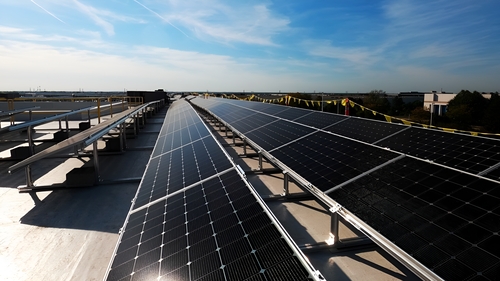Solar Panel Cleaning and Maintenance: Why Access Matters
6 May 2025

Installing solar panels on flat commercial rooftops is a smart way to lower energy bills and improve sustainability. But what happens after the system is commissioned and operational? For many property managers and facility teams, operations and maintenance (O&M) become a recurring challenge—especially when access is an afterthought.
In this article, we explore why access is one of the most critical—but often overlooked—factors in flat roof solar system design, and how it directly affects maintenance costs, energy yield, and long-term system performance.
The Importance of Regular Solar Panel Cleaning
Dust, pollen, bird droppings, snow accumulation, and air pollution all reduce the efficiency of solar panels.
For commercial and industrial systems, the stakes are higher: more panels mean more surface area exposed to debris and more potential revenue lost due to inefficiencies.
Regular cleaning is essential, but without proper access, it becomes a costly and time-consuming process.
Why Flat Roof Access Is Complicated
Flat roofs present unique challenges for solar maintenance:
-
Low-clearance designs can make it physically difficult—or impossible—to reach the center of an array.
-
Tight row spacing restricts movement between panels.
-
Overly complex structures with too many pieces increase the time and labor required for basic tasks.
-
Lack of underside access can slow down inspections of wiring, mounting hardware, and membrane conditions.
When systems are difficult to access, routine maintenance gets delayed—or skipped altogether. This leads to faster component degradation, higher long-term costs, and more frequent system shutdowns for repairs.
Poor Access = Higher O&M Costs
Many stakeholders underestimate the long-term costs associated with poor design choices. In reality, access-related challenges have a ripple effect:
-
Longer service times increase labor costs.
-
More equipment required (e.g., scaffolding, lift platforms) adds to O&M expenses.
-
Increased risk of accidental damage during maintenance, especially on crowded or poorly supported arrays.
-
Full or partial system shutdowns may be required just to inspect or clean a small section.
The result? A system that looked good on paper becomes operationally inefficient, and maintenance budgets balloon over time.
Designing With Maintenance in Mind
Proper planning during the design phase can significantly reduce O&M complexity:
-
Elevated racking systems create space beneath the panels, allowing for easy access during inspections and cleanings.
-
Open-back structures reduce the number of tight, unreachable spots.
-
Long-span designs minimize the number of obstructions and allow technicians to move safely and efficiently.
-
Optimized load distribution means fewer roof penetrations, which not only protects the membrane but also reduces the risk of water leaks—one of the most expensive O&M issues on flat roofs.
By thinking beyond the installation day, system designers can provide long-term value and peace of mind to building owners.
Access Is an Investment
Access is not a luxury—it's a necessity for any high-performing solar installation. By prioritizing accessibility in your system design, you reduce long-term costs, increase system uptime, and ensure your solar investment continues to deliver returns year after year.
Whether you're a building owner, solar developer, or EPC contractor, the message is clear: smart design starts with smart access.